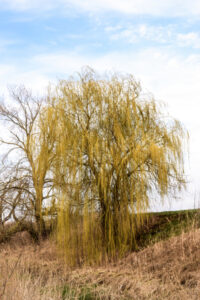Willow trees are famous for their beautiful shapes and love of water. The most recognizable willow tree species are the pussy willow and the weeping willow. However, there are many other willow types in Asia, North America, and Europe. You may recognize these trees by inspecting their different characteristics, such as willow tree leaves. To aid in correctly classifying the willow trees, you could reference a tree field guidebook.
As a collection, willows are simple to categorize. As a matter of fact, pussy willows are the top recognizable willows of most individuals. Though making a distinction between various types of willows is an entirely different story.
The reason is that there are a vast number of willows. North America has over 85 different willow tree types. Several of the types interbreed, with the progeny having features of both parents. As a result, most folks are happy knowing that they have a willow tree and leave it at that.
You can recognize a weeping willow by its little trunk, sagging, long limbs that reach the ground, growing up to 70 feet.
Classifying by Willow Tree Leaves
If you’re classifying willow trees by their leaves, look for slim, long, somewhat broad leaves. These leaves are usually smooth, shiny, and non-lobed, with thin double teeth near the edges to recognize the shining willow. This willow tree type grows over 20 feet tall and has reddish-brown, smooth bark. The bright willow has hairy, little seeded fruits.
Pussy Willow
Identify a pussy willow (aka the glaucous willow) by searching for its hedge-like shape and small size, growing just 25 feet tall.
The hairy catkins on a pussy willow tree are the biggest of all the willow types. The tree possesses slim, long leaves with double-toothed edges and colorless undersides. The bark is a brownish red, beginning as smooth and getting scaly as the tree gets older.
Crack Willow
Distinguish the crack willow tree by its crinkled, lopsided bark that runs from dark brown to dark gray. The crack willow has yellow, stiff branches that develop to over 75 feet tall. The six-inch leaves have pale undersides and double teeth close to the leaf’s edges.
Black Willow
Watch for leaves that are green and slim on both sides to spot the black willow. The black willow flourishes between 30 to 50 feet tall with a trunk that’s one to two inches in diameter. Tiny stipules are on both sides of the leaf stalk near the leaves.
If you’re wondering which willow type may work well in your garden or landscape, you’ll want to begin by deciding how much space you have and what growing environments you can provide.
People also use willows to make sculptures and living fences. The limbs play a significant role in basket weaving. The branches become extremely bendable when soaked in water.
Willows thrive in wet soils, typically close to bodies of water, including swamps, rivers, streams, and lakes. Most willows possess robust and expansive root systems. Reach out to Mechanicsburg Tree Service in Mechanicsburg, PA, to learn more about classifying willow trees.


Recent Comments